TREVMI – Indonesia the world’s largest archipelago, is not only famed for its tropical beauty and diverse cultures, but also for its rich collection of ancient temples that draw admiration from international travelers. Nestled in the heart of Central Java and Yogyakarta, these sacred monuments are more than just tourist destinations, they are windows into a past that shaped the spiritual and cultural landscape of Southeast Asia.
Among the most captivating are the temples near Yogyakarta, including Borobudur, Prambanan, and several other hidden gems, each telling their own story through intricate carvings, majestic stonework, and profound spiritual symbolism. These ancient temples in Java have become top cultural heritage attractions, consistently sought after by foreign visitors seeking not only picturesque sites, but also a deeper understanding of Indonesia’s historical legacy.
From towering Buddhist stupas to serene hilltop sanctuaries, temple tourism in Central Java offers an unforgettable blend of history, art, and nature.
As a leading travel agency in Yogyakarta, Trevmi Nusantara specializes in curating immersive temple experiences that connect global visitors with the soul of Java. With expertly guided tours, customizable itineraries, and a deep respect for cultural preservation, Trevmi Nusantara ensures that every journey is both enlightening and seamless.
In this article, we explore 7 must-visit temples in Java that continue to captivate international travelers, offering insights, travel tips, and the historical significance behind each sacred site.
Borobudur Temple – A Majestic Buddhist Wonder
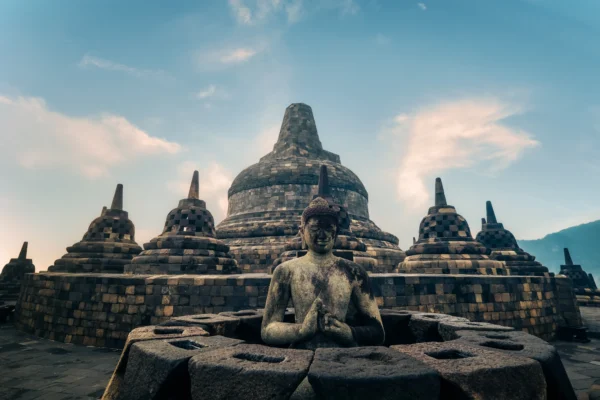
Standing as the world’s largest Buddhist temple, Borobudur Temple is a monumental symbol of Indonesia’s rich spiritual and artistic legacy. Located in Magelang, Central Java, just an hour’s drive from Yogyakarta, this 9th-century Mahayana Buddhist temple is one of the most visited cultural heritage sites in Southeast Asia, attracting scholars, pilgrims, and tourists from around the globe.
Designated a UNESCO World Heritage Site in 1991, Borobudur is a stunning example of ancient architecture and religious symbolism. Built in the form of a massive mandala, the temple consists of nine stacked platforms topped by a central dome, adorned with over 2,600 relief panels and 500 Buddha statues. Each level represents a stage of spiritual enlightenment, offering visitors a literal and metaphorical journey from the earthly realm to Nirvana.
One of the most iconic experiences at Borobudur is witnessing the sunrise over the Kedu Valley, where morning light bathes the temple in a golden glow and mists rise gently between its stupas. This has become a bucket-list activity in Java for many international travelers seeking both natural beauty and spiritual resonance.
Beyond its breathtaking design, Borobudur holds deep philosophical meaning, reflecting the teachings of the Buddha through stone carvings that narrate stories of compassion, karma, and enlightenment. For many, a visit here is not just sightseeing it is a moment of reflection.
Prambanan Temple – The Hindu Masterpiece
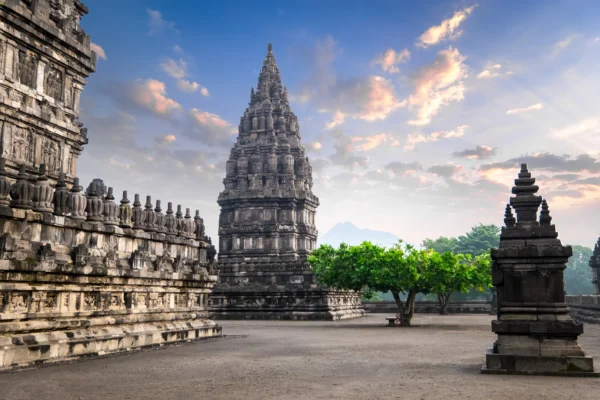
Just 17 kilometers from Yogyakarta lies Prambanan Temple, a majestic Hindu temple complex that stands as one of the greatest archaeological sites in Southeast Asia. Built in the 9th century, Prambanan is dedicated to the Hindu Trimurti Brahma the Creator, Vishnu the Preserver, and Shiva the Destroyer. It is Indonesia’s largest Hindu temple and was declared a UNESCO World Heritage Site in 1991, alongside its Buddhist counterpart, Borobudur.
Towering at 47 meters, the central temple of Shiva Mahadeva dominates the skyline with its pointed spires and intricate stone reliefs. These carvings vividly narrate the epic story of the Ramayana, an ancient Sanskrit tale of love, loyalty, and divine warfare. For history lovers and cultural travelers, Prambanan offers an immersive glimpse into the spiritual and artistic legacy of classical Java.
A unique highlight for many international visitors is the Ramayana Ballet performance, held in an open-air theater with Prambanan as its dramatic backdrop. Combining traditional Javanese dance, music, and storytelling, the show brings the ancient legend to life under the stars a perfect fusion of heritage and entertainment.
Unlike many ancient temples, Prambanan is not just admired from afar; it is meant to be explored. Visitors can walk among the temples, feel the texture of time-worn stones, and absorb the spiritual energy that continues to resonate in this sacred space.
Mendut Temple – The Spiritual Companion of Borobudur
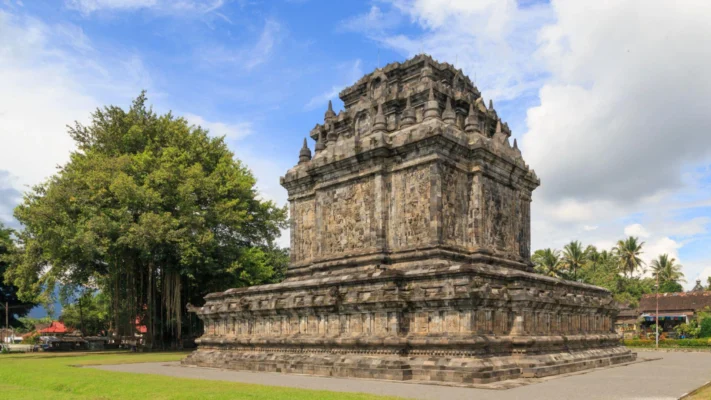
Located just 3 kilometers east of the iconic Borobudur, Mendut Temple may appear modest in scale, but it holds profound spiritual and historical significance. This 9th-century Buddhist temple is considered part of a sacred triad along with Borobudur and Pawon, forming a pilgrimage route that reflects ancient Buddhist cosmology in Central Java.
What distinguishes Mendut Temple is its serene atmosphere and the presence of a large, well-preserved statue of the seated Buddha Dhyani. Flanked by two bodhisattvas Avalokitesvara and Vajrapani this main chamber creates a tranquil space for meditation and prayer, often visited by monks and devotees from around the world. As such, Mendut is more than a tourist site it is a living temple that still pulses with spiritual activity.
The temple’s relief panels also offer intricate depictions of Jataka tales, or stories from the previous lives of the Buddha, making it a treasure trove for both scholars and culturally curious travelers. These carvings, while smaller in scale than Borobudur’s, carry deep philosophical messages about kindness, wisdom, and human values.
Mendut Temple plays a vital role during Waisak Day celebrations, when thousands of Buddhist devotees gather for a ceremonial procession from Mendut to Borobudur. This sacred event, held on the full moon of May, draws international pilgrims and photographers alike, highlighting Mendut’s position as a key spiritual site in Central Java.
Ratu Boko Temple – Temple with a Royal Touch
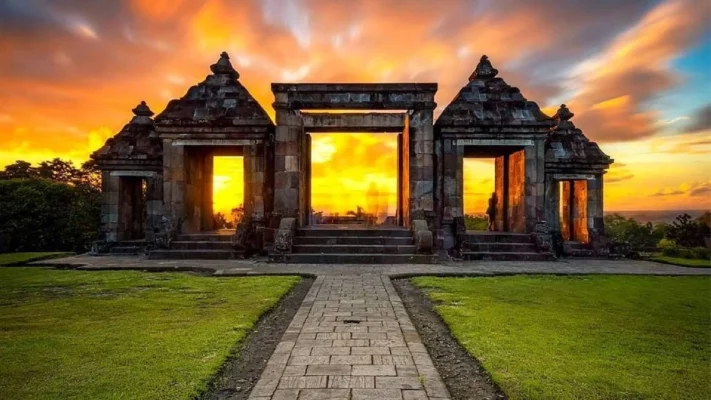
Perched on a plateau about 196 meters above sea level, Ratu Boko Temple offers more than just ancient ruins it offers a glimpse into the grandeur of a royal palace complex from 8th-century Java. Located just a few kilometers south of Prambanan Temple, this archaeological site is shrouded in mystery and elegance, combining spiritual significance with regal ambiance.
Unlike typical temples built for worship, Ratu Boko is believed to have served as a royal residence or fortified palace, evidenced by its unique layout, including gates, bathing pools, audience halls, and pavilions. These structures suggest a complex that once thrived as a center of both political power and spiritual practice, blending Hindu and Buddhist influences.
Visitors are often captivated not only by the historical intrigue but also by the spectacular scenery. As one of the best sunset spots in Yogyakarta, Ratu Boko offers panoramic views of Prambanan Temple and Mount Merapi, especially magical as the sun dips behind the horizon. The dramatic silhouette of the ancient gates against a fiery sky has made this site a favorite among photographers and travelers alike.
Beyond the visual beauty, Ratu Boko provides a serene and contemplative atmosphere. Walking through its stone corridors and open courtyards, one can easily imagine the ancient royals gazing out over the lush plains below a perfect blend of historical depth and scenic allure.
Selogriyo Temple – Hidden Gem in the Hills
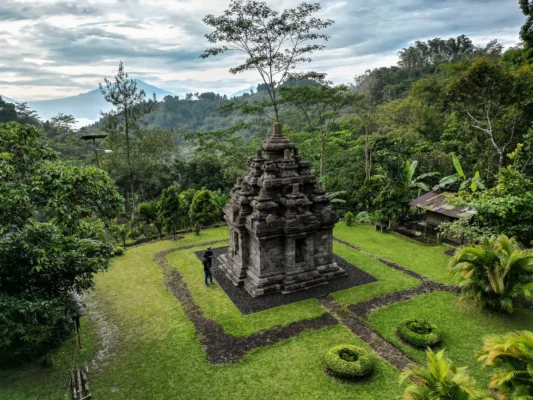
Tucked away on the lush slopes of Mount Sumbing in Central Java, Selogriyo Temple offers a tranquil escape from the well-trodden tourist path. This small Hindu temple from the 8th century may not match the grandeur of Borobudur or Prambanan, but its secluded location and serene atmosphere make it one of the best-kept cultural secrets in Indonesia.
The journey to Selogriyo Temple is as rewarding as the destination itself. Visitors must trek through scenic rice terraces, bamboo forests, and winding village trails an immersive experience that introduces them to the breathtaking rural charm of Central Java. It’s no surprise that many describe Selogriyo as a “temple in the clouds,” where nature and spirituality exist in perfect harmony.
Architecturally, the temple reflects early Hindu design with simplicity and symmetry. It is believed to have been dedicated to Lord Shiva, and although smaller in size, the temple’s intricate reliefs and well-preserved stonework speak to the artistry of the ancient Javanese. The peaceful surroundings only enhance the meditative quality of the site, making it a favorite for travelers seeking spiritual solitude and cultural reflection.
Due to its remote location, Selogriyo remains relatively untouched by mass tourism, preserving its authenticity and natural setting. This makes it an ideal destination for those looking to explore off-the-beaten-path temples in Indonesia.
Ijo Temple – Where History Meets the Sky
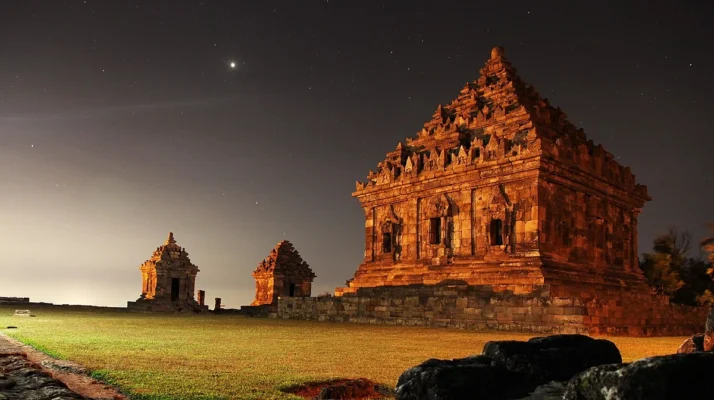
Standing at approximately 410 meters above sea level, Ijo Temple (Candi Ijo) holds the distinction of being the highest Hindu temple complex in Yogyakarta. Overlooking the fertile plains of Prambanan and the sprawling cityscape beyond, this ancient site offers not only a historical journey, but also one of the most breathtaking panoramic views in Central Java.
Dating back to the 9th century, Ijo Temple is believed to have been constructed during the Mataram Kingdom era. The complex consists of several smaller temples (perwara) surrounding a central main temple, all dedicated to Hindu deities most notably Shiva. The temple’s name, “Ijo,” means “green” in Javanese, reflecting the lush hill where the temple quietly resides.
Although less famous than Borobudur or Prambanan, Ijo Temple’s archaeological significance continues to draw historians and cultural travelers alike. Intricate carvings on the temple walls depict stories from Hindu mythology, symbolizing spiritual protection and cosmic balance. From a heritage perspective, Ijo plays a vital role in understanding the spread of Hindu influence in ancient Java.
What truly elevates the experience both literally and metaphorically is the view. As the sun begins to set, visitors gather at Ijo Temple for one of the most iconic sunsets in Yogyakarta. The golden light dances over the stone structures, while Mount Merapi looms in the distance, often shrouded in mist. It’s a moment that merges history, spirituality, and natural beauty in perfect harmony.
Sambisari Temple – The Underground Marvel
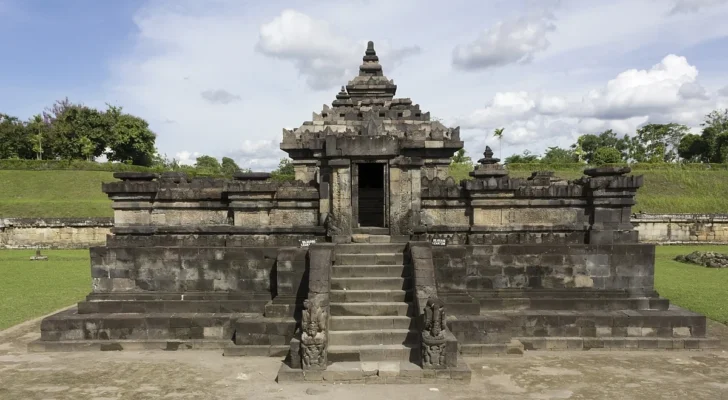
Discovered accidentally by a farmer in 1966 beneath layers of volcanic ash, Sambisari Temple is often referred to as Yogyakarta’s hidden underground temple. This 9th-century Hindu sanctuary, buried for centuries due to a massive eruption from Mount Merapi, now stands as one of the most unique and well-preserved archaeological sites in Indonesia.
Unlike most temples in Java that stand prominently above ground, Sambisari lies about 6.5 meters below the current surface level. Visitors descend a series of stone steps to reach the temple courtyard, giving the entire experience an atmosphere of mystery and discovery. Surrounded by manicured lawns and quiet paths, the site offers a peaceful setting ideal for cultural reflection and exploration.
The temple complex consists of a central main temple dedicated to Lord Shiva, flanked by three smaller perwara temples. Its architectural elements such as intricate stone reliefs, guardian statues (Dvarapala), and lingam-yoni symbols reflect the spiritual artistry of the ancient Mataram Kingdom. Despite being buried for more than a thousand years, much of the structure remains intact, a testament to the craftsmanship of early Javanese builders.
Sambisari’s underground nature has fascinated historians and travelers alike. It is not only an impressive example of subterranean temple architecture in Indonesia, but also a reminder of the powerful forces of nature that have shaped the region’s landscape and history. The temple is also a favorite among photographers, especially during the early morning hours when soft light enhances the texture of the stones and shadows add depth to the sunken courtyard.
Why Choose Trevmi Nusantara for Your Temple Tours?
When it comes to exploring the best temple tours in Yogyakarta, Trevmi Nusantara stands out as your trusted partner in crafting meaningful and unforgettable journeys. As an internationally recognized Indonesian travel agency based in Yogyakarta, we specialize in curated temple experiences designed to immerse you in the heart of Java’s ancient heritage.
Our temple tours are more than just sightseeing they’re cultural expeditions led by knowledgeable local guides who are passionate about history, architecture, and spirituality. From the grandeur of Borobudur Temple to the hidden charm of Selogriyo Temple, Trevmi Nusantara ensures each visit is insightful, comfortable, and authentically Indonesian.
With our deep understanding of the region, we offer:
- Personalized itineraries tailored to your interests, whether you seek sunrise views, spiritual walks, or architectural marvels.
- Multilingual guides to accommodate international travelers from all over the world.
- Comfortable and reliable transport, so you can explore remote temples like Ijo Temple or Sambisari Temple with ease.
- Exclusive access and timing strategies, such as sunset tours at Ratu Boko or early morning visits to Borobudur before the crowds arrive.
Our commitment to hospitality, cultural integrity, and seamless travel logistics has made us a preferred choice for travelers looking to explore the temple treasures of Central Java.
Conclusion
Yogyakarta is a timeless gateway to some of the most extraordinary ancient temples in Southeast Asia. Each temple whether it’s the monumental Borobudur, the elegant Prambanan, or the sunken sanctuary of Sambisari tells a story of devotion, artistry, and the civilizations that once thrived on this volcanic land.
Choosing Trevmi Nusantara means more than booking a tour it means stepping into centuries of spiritual and architectural brilliance, guided by those who know it best. Whether you’re planning your first trip to Java or returning to deepen your experience, let us be the bridge between your journey and Java’s majestic legacy.
Discover the temples of Yogyakarta with Trevmi Nusantara where history, culture, and adventure unite.



